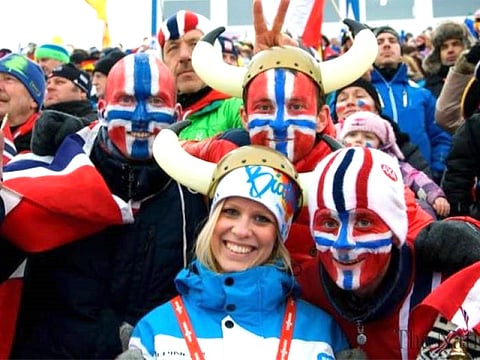Nordic countries’ ‘happy’ reputation masks sadness of young, says report
Significant minority of young people in Denmark, Finland, Norway, Sweden and Iceland ‘struggling or suffering’

Helsinki: The Nordic countries top the polls as the happiest in the world.
But the assumption that life in Scandinavia is all bicycles and big smiles disguises the sadness of a significant minority of young people, it has emerged.
Among those in Denmark, Finland, Norway, Sweden and Iceland who do not say that life is good, some of the largest numbers are among the young, and particularly young women.
While the reasons will vary from one individual — and one country — to another, it is thought that stress, loneliness and feeling under pressure to succeed may be playing a large part in their unhappiness.
Contentment in the Nordic nations has been the envy of the rest of the world.
In indexes of global happiness from the UN and the OECD — measured not just by wealth but also by people’s own sense of satisfaction with their lives — the same clutch of countries always come out top.
This year Finland took first place in the UN’s World Happiness Report league table, even though its GDP is below that of the US and Germany.
Nuanced picture of happiness
But the Nordic Council of Ministers, a collaboration of the five countries plus the Faroe Islands, Greenland and Aland, decided to look at those who did not appear so happy.
The result was a report co-authored by the Happiness Research Institute in Copenhagen which provides “a more nuanced picture”, it says.
“There are also those who report to be struggling or even suffering when they evaluate their own lives.”
Faced with a happiness survey, it is normal for people living in Nordic countries to score seven, eight or nine out of 10, says the report.
“A value of less than seven can therefore be seen as a deviation,” it says.
They looked at those who scored between five and six, whom they classified as struggling, and those who scored between zero and four, deemed to be suffering.
In Nordic countries, they found, 12.3 per cent of the population are struggling or suffering.
That rose to 13.5 per cent of the 18 to 23 year age group.
Young women
Among Swedish young women, it is 19.5 per cent — nearly one in five — compared with 13.8 per cent of Swedish young men.
The only age group less happy than the young were the oldest.
Among the over-80s, 16 per cent were struggling or suffering, with physical health problems and loneliness thought to be the biggest factors.
Michael Birkjaer of the Institute, one of the authors, said young people were increasingly reporting higher stress levels and loneliness around the western world.
“More and more young people are getting lonely and stressed and having mental disorders,” said Birkjaer.
Perfectionism, social media
“We are seeing that this epidemic of mental illness and loneliness is reaching the shores of the Nordic countries.”
The reasons were guesswork, he said — although the Institute plans further research.
“We have some evidence as to where the problem may lie. In Denmark the perfectionism culture is a huge topic.”
Young people feel they are expected to excel in exams — something referred to as “the 12th grade culture”, he said.
“It is a huge debate in Denmark and not something we can ignore.”
It may be that the world appears a harder place in which to prosper.
“We have seen these decreases in happiness in many countries since the financial crisis, even though countries like Denmark have regained economic growth.”
Social media may also play a part in the unhappiness of the young, he said.
A previous government study had shown high levels of loneliness in young people.
Many say they are alone when they would like to be with the people they see on Facebook or Instagram apparently having a good time.
Taking into account all age groups, poor general health was most often reported by those who appear to be struggling or suffering.
Meantal health
Poor mental health came second, followed by inequality of income, unemployment and limited social contact, which the authors used as a proxy for loneliness.
Older men who were unhappy were less likely to see family and friends than older women.
Among the young, mental health is the biggest factor. The report says it has worsened in Nordic countries.
“In Norway, for example, an increase of 40 per cent was seen over a five-year period in the proportion of young people seeking help with mental health problems. In Denmark, 18.3 per cent of young people between 16 and 24 years suffer from poor mental health.
This number comprises an average of the 12.9 per cent recorded for men and as many as 23.8 per cent for women.
Related: How do you build a healthy city? Copenhagen reveals its secrets
Stress, depression, anxiety
“Mental health problems among young people manifest themselves in the form of stress, depression, anxiety, self-harm, consumption of antidepressants and, in extreme cases, suicide.
The latter is a particularly big problem in Finland, which otherwise ranks as the happiest country according to the World Happiness Report 2018. Here, suicide is responsible for one-third of all deaths among 15-24 year olds.”
Ulf Andreasson, senior adviser in the policy analysis and statistics unit of the Nordic Council of Ministers and an author of the report, said they wanted to look further because everybody knows people who are not happy, in spite of the image.
“We also had a feeling that being unhappy in the Nordic countries perhaps comes with some kind of stigma,” he said.
“If everybody is happy and I’m unhappy, is it OK to give voice to that? We wanted to de-stigmatise being unhappy.”
— Guardian News & Media Ltd
Sign up for the Daily Briefing
Get the latest news and updates straight to your inbox



